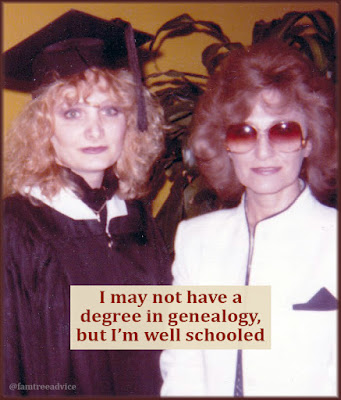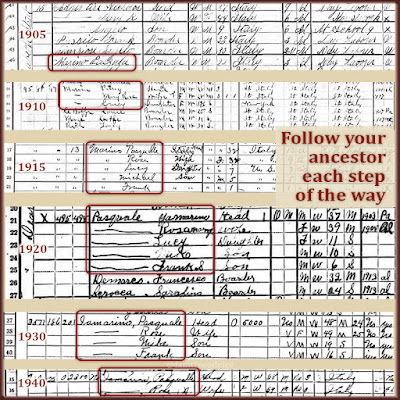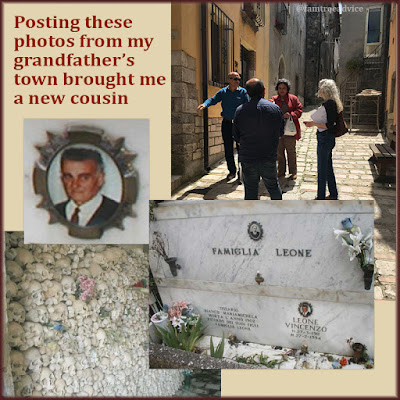I followed this basic research advice and made an absolute genealogy killing.
Last week I watched YouTube videos by Crista Cowan, a chief genealogist at Ancestry.com. Crista recommends you start each genealogy research session with a question.
What do you want to know? Form a question, then figure out which documents might hold the answer. As you search:
- keep that question in mind
- think about what other documents might help.
Yesterday I realized I was doing exactly what Crista described. I'd heard from a new DNA match whose paternal grandparents' last names were familiar to me. Her grandmother's name seemed like a misspelling of my grandmother's name, Sarracino.
Here's what my thought process looked like.
My 1st Question: Was Concetta Saraceno really Concetta Sarracino?
Documents to search: U.S. and New York censuses
Documents to search: U.S. and New York censuses
I needed to find Concetta and her husband in the U.S. census. All I had were their names and approximate birth years. A census can tell you an immigration year. An immigration record can tell you a hometown.
On the 1915 New York census, Concetta and her husband and kids live with her parents. Their names are Mike and Antonia Sarracino. Mike Sarracino was born in 1858. I needed to check other census years.
I found Concetta's father's name as Angelo more than Mike. And there's always a different misspelling of Sarracino. On the 1900 census he's Angelo M Sarracino. He's married, but alone.
Based on census records, I do think Concetta Saraceno is Concetta Sarracino. They even lived on the same Bronx street as my grandmother and her family. But it's only circumstantial evidence.
 |
| Each document you find will hold some sort of clue. |
My 2nd Question: Where did Concetta and her father come from in Italy?
Documents to search: Immigration and naturalization papers
Documents to search: Immigration and naturalization papers
I searched for Angelo Sarracino's immigration and naturalization papers. I found his U.S. passport application.
Was he from the same little hamlet as my Sarracino ancestors? They were from Pastene ending in an E. There's a different town of Pastena ending in an A.
In fact, there are a few towns named Pastena ending in an A. But none of them are in my family's Benevento province.
He signed his passport application as Angelo Michele Sarracino. The document states the following:
- Angelo Michele Sarracino was born on 29 Sep 1858 in Pastena, Benevento. If it didn't say "Benevento" I would think it was the wrong town.
- His wife is Mariantonia Bianchini. She is Antonia on the 1915 census, but that's very common.
- He has a daughter Concetta who was born on 5 Feb 1886 in Pastena, Benevento.
- He has a daughter Rosaria who was born on 22 Sep 1888 in Pastena, Benevento.
The document also has some immigration dates I can research. But what made me light up was his witness. The signature is a name I know well. It's a name from my family's town. He signed the paper:
Pastore Carmine
Pastene
Pastene
...ending in an E.
With Concetta and Rosaria's birth dates, I can check my collection of Pastene vital records.
Of course, they're not there.
My 3rd Question: Did Angelo Michele Sarracino return to Italy to bring back his wife and daughters?
Documents to search: Ship manifests
Documents to search: Ship manifests
Angelo's passport application says he was in the U.S. continuously from 1890 to May 1904.
He went home to Italy on 31 May 1904. Now, in June 1904, he's preparing to return to New York.
I searched passengers lists for Angelo Michele Sarracino in 1904. No luck. I searched for Concetta Sarracino, his daughter. No luck. I searched for Mariantonia Bianchini, his wife. And I found the whole family.
 |
| Who else is with your people when you find them? |
The ship manifest says Angelo was in America from 1894–1904, but his wife and children were not. Because Angelo was a U.S. citizen, the whole family gets discharged on the pier.
Their hometown is still infuriatingly written as Pastena. But there's a welcome surprise on the next line. It's Angelo Muollo and his family from just outside Pastene. This is my family. My great grandfather Giovanni Sarracino's mother was a Muollo.
The ship manifest doesn't list a family member in Italy. So I can't connect Angelo—and my DNA match—to other Sarracino family members. The birth records for Pastene are not available before 1861.
My 4th Question: How can I connect Angelo to my family?
Documents to search: Vital records
Documents to search: Vital records
I couldn't find Concetta and Rosaria's birth records. But then I remembered what happened with my great grandfather. He was born in Pastene in 1876. But his father didn't officially declare the birth until 1898. He had to do it so Giovanni could legally marry.
Maybe Concetta and Rosaria's births were filed late, too. Maybe they were registered just in time to sail to America.
I searched the town's birth records year-by-year, starting in 1904 and going backward. I found 3 other Sarracino's whose birth were reported years late. What was up with my family?
Finally I found the goods. On his 1904 passport application, Angelo got his daughter Rosaria's birth date wrong. I found her exactly one year later. She was born on 22 Sep 1889, not 1888. And I learned that Angelo's father-in-law was Giovanni.
Gasp! Does that mean I might find Concetta's birth record in the wrong year, too? Yes it does! Concetta Maria Domenica Sarracino was born one year later than it says on her father's passport.
 |
| This is why I keep all the vital records on my computer! |
Now I'm sure my new DNA match is a Sarracino from Pastene like my mom and me. I still don't know who Angelo's father was, so I don't know the exact relationship.
My 5th Question: How can I find the names of Angelo's parents?
Documents to search: More vital records
Documents to search: More vital records
An Ancestry search tells me Angelo died in New York on 7 Feb 1931. His Manhattan death certificate is number 4251. But I can only see it by visiting the New York City Municipal Archives. I'm not able to do that. UPDATE: New York City put a lot of vital records online, so I was able to download Angelo's death record. His daughter Concetta was the informant.
My last resort is to go through all the vital records I have from Pastene. I may be able to piece together Angelo and his wife's families. Only then will I know my exact relationship to my DNA match.
I didn't even mention how I tracked down my match's grandfather with only his name and birth year. Census forms and ship manifests led me to a town called San Nicola Manfredi. Would you believe it's the town next door to Pastene?
So, to make your genealogy research more productive, follow Crista Cowan's advice. Ask the question and figure out which records can get you the answer.
And speaking of research efficiency:












